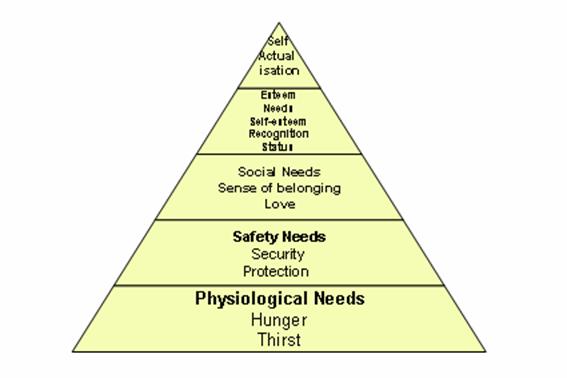Every organization functions when all the faculties are at their best state. There is intense need for motivation of the different levels of the work force. Motivation is more of a psychological than physical. There are therefore, theories made to help motivators come up with the appropriate methods and tools for their group. There are many theories but the major ones are discussed in this document.
The first theory is that of the Abraham Maslow. His theory focuses on the needs of employees. He sees the needs to exist in hierarchy; they ascend from the lowest to the highest. He also put across the fact that when a need is satisfied it stops being a motivator and the worker will tend to pursue the next level of needs. Maslow urges that the human needs are broken down into five major parts. A diagram below expresses this.
.

Physiological needs are at the bottom of the pyramid. These needs are as a result for human survival and sustenance. These needs are food, water, warmth, shelter, sleep and education. For motivation to work a degree of these needs has to have been met.
The second level of need is the need of safety. This is the need to be free from any physical danger and any losses. The losses may be of property, shelter, food or encounter any emotional harm.
The third type is the social needs. The human beings are a very social being. There is often the need to feel accepted and to belong to a society.
The fourth level contains the esteem needs. After the need to belong has been satisfied the person tends to want to be held n high esteem by the society and themselves. The result of such a need is power, prestige and self-confidence. The aspects of esteem are self-respect and making great achievements.
The fifth and final need is that of self-actualization. According to Maslow (3) this is the highest level of human need and it incorporates growth, achieving one’s full potential and getting the self-fulfillment that is required. The need is based on accomplishing something while making use of one’s full potential.
The second theory is that of Frederick Herzberg. He argues that a business can introduce some factors to motivate its employees directly. He views the factors the external factors that surround a job as hygiene factors. He views the wages of work as a hygiene factor. He views promotions, how interesting work is and room for more responsibility as key job motivators. He claims that to increase work output the content of jobs should be revised, enriched and enlarged.
The third theory is by Frederick Winslow Taylor. He, thorough his work states motivation can only exist in the form of pay. He points out that work is not a joy to many and hence need for control and close supervision. This theory leads to mass production and has encountered opposition from employees. The three theories do not totally explain the human behavior. They only do not focus on the employees’ home environment, health status, background and they assume that all people have similar needs at one given time.
The body chemistry and the Brain trigger hunger. The activities of the gastric juices are the basis of hunger. Hunger is motivated by external factors such as the site of a meal or the memory of a last meal. Taste is managed by Taste receptor cells, which report a sensation of taste from food to centers in the brainstem. Tastes trigger the type of digestion to occur.
In conclusion, motivation is the key driving force in both the industries and human body system. The three mentioned theories of motivation should help motivators know how to manage their groups accordingly.
Work Cited
Maslow, Abraham. Understanding Human Motivation. Cleveland: Howard Allen Publishers, 1958.